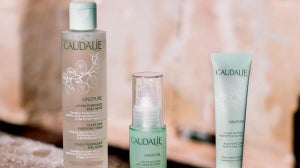
Dry skin can be a frustrating and uncomfortable issue, especially when it affects your face. Whether it’s the tightness, the flakiness or that constant itchy feeling, it has a way of making itself known.
But don’t worry, there are ways to address it. Whether you want to know the key causes, or the main symptoms to look out for, our guide advises on how you could give your skin the moisture boost it needs.
What Causes Dry Skin on the Face?
Understanding the root causes of dry skin is the first step in finding the right solution. There are several factors that can contribute to that parched feeling, and it’s often a combination of these at play.
Over-Washing
One common culprit is excessive washing. While it’s important to cleanse, over-washing may strip away your natural oils, which work to create a protective barrier.
Kirsty Gainey, Account Head of R&D at THG Labs notes, “Sebum is crucial for maintaining the skin’s moisture balance. When you remove too much of it, the skin could lose some of it’s its ability to protect itself from external factors.”
Environmental Conditions
Another potential cause is environmental conditions. As Gainey explains, “Factors like humidity and temperature can lead to moisture loss from your skin and impact your skin’s hydration levels, making it more prone to dryness.”
Hormonal Fluctuations
Hormonal shifts could also come into play. Gainey states, “Decreased sebum production could also exacerbate dry skin, which can be influenced by hormonal changes.” It’s also believed that age may affect these fluctuations.
Skin Conditions
Lastly, Gainey mentions that underlying “skin conditions like dermatitis or eczema could cause dryness.” This is because they could potentially disrupt the skin’s barrier function, making it difficult for it to retain moisture.
What Does Dry Skin Feel Like?
If you’ve ever had dry skin, you know it’s not just about appearance - it’s about how it feels, too.
Without proper care, our expert states “dry skin can be really uncomfortable,” and “it can feel tight, sore and itchy, often appearing red and visibly flaky.”
It’s important to note that if any of these symptoms are causing you discomfort, it’s worth talking to your GP or a dermatologist for more information.
How to Hydrate Dry Skin
The good news is, there are plenty of ingredients out there that could help to soothe and hydrate it. THG Labs tells us which three groups of ingredients should be on your radar.
Gainey explains that we should consider ingredients that work to create a “protective layer on top of the skin, which is essential for preventing further moisture loss. These ingredients include things like vegetable oils and petroleum jelly.”
Incorporating humectants like glycerin into your routine might also be beneficial, as ingredients like these could help to “attract water and can hold onto it to help hydrate the skin.”
Lastly, Gainey recommends calming ingredients such as oat extract, noting it “can help the skin to feel soothed”, helping to reduce the potential feeling of irritation that comes with dryness.
By understanding the causes and symptoms of dry skin and choosing the right ingredients to hydrate and protect it, you could keep your complexion feeling more comfortable.
Incorporating moisturiser into your daily skincare routine could be the first step to more hydrated skin. Discover our guide on how to apply it, so you can maximise its benefits.








